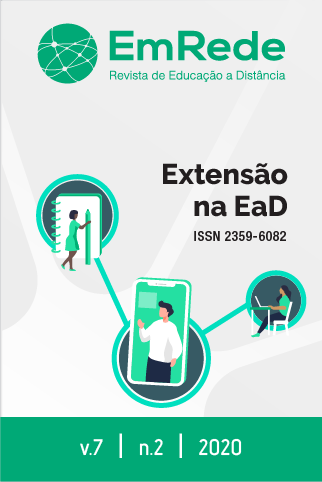Distance Education in a military context: instructional design as an auxiliary tool in the process of modeling a discipline
DOI:
https://doi.org/10.53628/emrede.v7i2.662Palabras clave:
Diseño Instruccional. Material didáctico. ADIÓ.Resumen
El presente trabajo relata la experiencia de la investigadora en su campo profesional, en el cual presentó una propuesta de Diseño Instruccional (DI) para la disciplina “Producción de Material Didáctico para la Educación a Distancia” para el Curso Preparatorio para Tutores (CPT) y tuvo como objetivo Locus del Grupo de Instrucción Táctica y Especializada (GITE), Organización de Enseñanza de la Fuerza Aérea Brasileña (FAB), es una investigación cualitativa, aplicada y exploratoria, que se presentó como un Trabajo de Finalización de Curso y consolidó conocimientos construidos durante la Especialización en Educación. Tecnologías y Educación a Distancia, en particular los conocimientos relacionados con la DI, que se utilizaron para el diseño y desarrollo de la propuesta. Para el desarrollo del DI se utilizó el modelo ADDIE DI, que hace referencia a las siglas en inglés del ciclo Analizar, Diseñar, Desarrollar, Implementar y Evaluar. Fue elegido porque entiende que es eficiente para trabajar en el contexto militar.
Descargas
Métricas
Citas
BARROS, Thiago Medeiros. Design Instrucional do Curso de Material Didático. Faculdade de Administração, Ciências, Educação e Letras - Facel, Curitiba, 2018.
BATES, Tony. Educar na era digital: design, ensino e aprendizagem. São Paulo: Artesanato Educacional, 2017. Disponível em: http://www.abed.org.br/arquivos/Educar_na_Era_Digital.pdf. Acesso em: 01 maio 2019.
BLOOM, B. et al. Taxonomia dos objetivos educacionais: domínio cognitivo. Porto Alegre: Globo, 1983.
BRASIL. Comando da Aeronáutica. Departamento de Ensino da Aeronáutica. Centro de Documentação e Histórico da Aeronáutica. Plano de Modernização do Ensino da Aeronáutica: PCA 37-11. Brasília, DF, 2017.
BRASIL. Ministério da Educação. Secretaria de Educação a Distância. Referenciais de qualidade para educação superior a distância. Brasília - DF, 2007. Disponível em: http://portal.mec.gov.br/ seed/arquivos/pdf/legislacao/refead1.pdf. Acesso em: 06 maio 2019.
COSCARELLI, C.; RIBEIRO, A. E. (org.). Letramento Digital: aspectos sociais e possibilidades pedagógicas. 3ed. Belo Horizonte: Ceale; Autêntica, 2011.
DEWEY, J. 1859-1952 Vida e educação: John Dewey. 10 ed. São Paulo: Melhoramentos, 1978.
FERRAZ, A. P. do C.; BELHOT, R. V. Taxonomia de Bloom: revisão teórica e apresentação das adequações do instrumento para definição de objetivos instrucionais. Gest. Prod. [online]. 2010, v.17, n. 2, p. 421-431.DOI: http://dx.doi.org/10.1590/S0104-530X2010000200015. Acesso em: 06 maio 2019.
FILATRO, A. Como preparar conteúdos para EAD. São Paulo: Saraiva, 2018.
FILATRO, A. Design Instrucional contextualizado: educação e tecnologia. 2. ed. São Paulo: Senac, 2007.
FILATRO, A. Design Instrucional na prática. São Paulo: Pearson Education do Brasil, 2008.
FILATRO, A.; CAIRO, S. Produção de conteúdos educacionais. São Paulo: Saraiva, 2015.
FREIRE, P. Pedagogia da autonomia: saberes necessários à prática educativa. São Paulo: Paz e Terra, 1996.
KENSKI, V. M. Educação e tecnologias: o novo ritmo da informação. 8. ed. Campinas, Sp: Papirus, 2012.
KLEIMAN, A. B. O conceito de Letramento e suas implicações para a Alfabetização. Cefiel/Unicamp & MEC, 2007.
LITTO, F. M.; FORMIGA, M. M. M. (org.). Educação a distância: o estado da arte. São Paulo: Pearson Education do Brasil, 2009.
MORAIS, M. et al. Design Instrucional na elaboração do material didático impresso na EAD do Instituto Federal do PIAUÍ (IFPI). CONGRESSO REGIONAL SOBRE TECNOLOGIAS NA EDUCAÇÃO, 2016.
MORAN, J. M. O que é um bom curso a distância? Disponível em: https://www.learning-performancebrasil.com.br/home/artigos/artigos.asp?id=2405. Acesso em: 23 dez 2018.
NEGRI, P. S. A intencionalidade pedagógica como estratégia de ensino mediada pelo uso das Tecnologias em Sala de Aula. Laboratório de Tecnologia Educacional. 2016. Disponível em: https://www.labted.net/single-post/2016/05/30/artigo-a-intencionalidade-pedag%c3%93gica-como-estrat%c3%89gia-de-ensino-mediada-pelo-uso-das-tecnologias-em-sala-de-aula-1. Acesso em: 23 dez. 2018. Acesso em: 20 abril 2019.
PEREIRA, J. T. Letramento Digital: aspectos sociais e possibilidades pedagógicas. In: COSCARELLI, C. V.; Ribeiro, A. E. (org.). Letramento Digital: aspectos sociais e possibilidades pedagógicas. 3ed., Belo Horizonte: Ceale; Autêntica, 2011.
Descargas
Publicado
Cómo citar
Número
Sección
Licencia
Derechos de autor 2020 Danielle Oliveira dos Santos, Thiago Medeiros Barros

Esta obra está bajo una licencia internacional Creative Commons Atribución-NoComercial-SinDerivadas 4.0.
Al enviar un artículo a la Revista EmRede y aprobarlo, los autores aceptan transferir, sin remuneración, los siguientes derechos a EmRede: los derechos de primera publicación y el permiso para que EmRede redistribuya este artículo y sus metadatos para indexar y hacer referencia a sus los editores consideren apropiado. En virtud de aparecer en esta revista de acceso público, los artículos son de uso gratuito, con atribuciones que permiten la distribución, remezcla, adaptación y creación en base a su trabajo, incluso con fines comerciales, siempre y cuando se dé el debido crédito a la creación originala la Revista EmRede.
Licencia Creative Commons - Atribución 4.0 Internacional (CC-BY).
